|

Bawa and tropical modernism
The fifth death anniversary of Sri Lanka's most prolific architect
falls today.
Ruwini Jayawardana
|
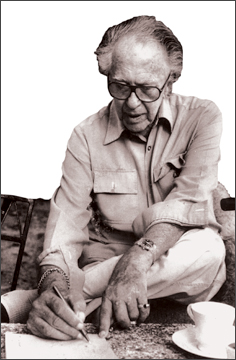
Geoffrey Bawa. Picture by Dominic Sansoni |
Geoffrey Bawa is Sri Lanka's most renowned architect who has moulded
many astounding creations of imagination into real-life replicas. His
work has had a tremendous impact upon architecture throughout Asia and
his creations are known to be some of the finest pieces of art in global
architecture and design. He is also the principal force behind what is
known as 'tropical modernism' today.
Geoffrey Bawa was born to a wealthy family in Ceylon while the
country was under the rule of the British in 1919. His father, Benjamin
Bawa, was a successful lawyer of Muslim and French parentage and his
mother, Bertha, mixed German, Scottish and Sinhalese descent.
His brother was the famed landscape gardener and aesthete Bevis Bawa,
the creator of 'Brief'. He was educated at Royal College, Colombo,
before attaining his BA at Cambridge University. He studied law at
Middle Temple, London and became a barrister in 1944. After World War II
Bawa joined a Colombo law firm but he was already showing signs of
tiring of the legal profession.
In 1946 Bawa took off on a journey, touring the Far East, USA and
Europe. His first wish had been to settle down in Italy, in a villa
overlooking Lake Garda but his dream never took shape. He returned to
Sri Lanka and bought an abandoned rubber estate at Lunuganga on the
Southern-West Coast between Colombo and Galle.
His goal was to bring the Italian element from the tropical
wilderness of the environment but he soon made the discovery that such a
transformation is impossible without technical knowledge.
In 1951 Bawa joined H.H. Reid, the sole surviving partner of the
Colombo Architectural Practice of Edwards, Reid and Begg. A year later,
after Reid's death, Bawa left for England to enrol as a student at the
Architectural Association in London. Bawa qualified as an architect in
1957 at the age of 38.
He returned to his motherland to take over what was left of Reid's
practice and soon gathered a cluster of talented young designers who
were equally enthusiastic about exploring and uncovering the secrets
behind the island's architectural heritage and discovering new ways in
designing and building monumental giants.
The group included many of Sri Lanka's most well-known faces
connected with creativity, designing and architecture: the batik
designer Ena de Silva, the designer Barbara Sansoni and the artist Laki
Senanayake. Ulrik Plesner, the young Danish architect, joined Bawa in
1959 and the two struck a close friendship and working relationship till
Plesner left for Europe in 1967. He also became an associate of the Sri
Lanka Institute of Architects during this period.
K. Poologasundram, an engineer, met Bawa and assisted him for the
following 20 years when the practice developed itself into carving a
niche in the field as many religious, social, cultural, educational,
governmental, commercial and residential buildings were attributed to
its name. A whole generation of fresh young talent joined the scene
through the practice.
One of Bawa's earliest works includes a courtyard house built in
Colombo for Ena de Silva. This domestic dwelling, set up in 1961 was
said to be the first to fuse elements of traditional Sinhalese domestic
architecture with the modern concept of open planning, bringing nature
into the creation.
Sri Lanka's first purpose-built resort hotel, the Bentota Beach
Hotel, took form in 1968 and soon a string of exquisitely designed
buildings creating an environment of a workplace set in the backdrop of
a tropical city followed.
His growing prestige was recognised in 1979 when he was invited by
President J.R. Jayewardene to design Sri Lanka's new Parliament in
Kotte. The swampy site was dredged to create an island at the centre of
a vast artificial lake, with the Parliament building symbolising an
asymmetric composition of copper roofs floating above a series of
terraces rising out of the water.
Bawa also designed the new Ruhunu University near Matara but both
these huge projects consumed much of his energy so much so that he took
refuge in his home in Bagatalle Road, Colombo, where together with a
group of young architects he engaged on toying with novel ideas in
designing.
Some of Bawa's most significant creations include the Sri Lanka
Institute of Architects Head Office, Club House, Ratnapura, Club
Mediterranee, Nilaveli, Club Villa Hotel, Bentota, Lunuganga, Bentota,
Jayewardene house, Mirissa and State Mortgage Bank, Colombo.
The Kandalama in Dambulla, the Lighthouse Hotel in Galle and the Blue
Water Hotel in Colombo are known as Bawa's masterpieces. Kandalama (now
known as Heritence Kandalama) is an austere jungle palace snaking along
a rocky outcrop at the edge of the ancient Kandalama reservoir, hidden
in the lush vines and surrounded by tropical wildlife.
The Lighthouse Hotel defines the Southern oceans from its rocky site
while the Blue Water Hotel is a cool pleasure pavilion set within a
sedate coconut grove on the edge of Colombo.
The renown architect won a number of national and international
awards for his work including the Chairman's Award of the Aga Khan Award
for Architecture in recognition of a lifetime's achievement in
contribution to the field of architecture in 2001.
In 1998, at the age of 79, tragedy struck. Bawa suffered from a
massive stroke which left him paralysed and unable to speak. A small
group of colleagues, led by Channa Daswatte went on to complete some of
the projects Bawa had initiated before his illness. Geoffrey Bawa, Sri
Lanka's master of architecture, passed away on May 27, 2003 and was
cremated on the Cinnamon Hill, Lunuganga.
Though five years have elapsed since his death, the creations he left
behind have never ceased to captivate and amaze witnesses of the present
generation as they did in the past.
Constant change was Bawa's forte
Renowned architect, Channa Daswatte had been working with Geoffrey
Bawa for many years. Following are excerpts from an interview with
Daswatte on which he shared his views on what it was like to have worked
with Sri Lanka's most influential architect.
|
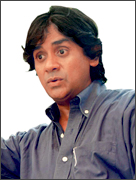
Architect
Channa Daswatte |
Bawa was known for using local materials, environment and traditions
in his creations.
At a time when Sri Lanka was having political ideologies that
encouraged self sufficiency and sustainability Bawa began to realise
that there is a society which had certain craft traditions and certain
abilities among its people which had gone completely modernist.
Adapting to ideas of the west was considered to be very fashionable
during that era. Geoffrey too started off like that because of his
western education but later he used the materials with the western
sensibility of space to see if buildings can be created using local
technology, material and skills. This method was used for one of the
first buildings he designed, the Ena de Silva house.
What do you consider as Bawa's greatest creation?
The Ena de Silva house is one of his greatest creations where he made
a big change in the way all of us would see Sri Lankan architecture.
We have lost the tradition of courtyards through the colonial period
and when he designed the house it was quite revolutionary.
Architecturally I would say one of his greatest creations is the
Kandalama hotel.
I feel that Geoffrey too would have agreed with this because for the
passion he had for it even after it was built. You can see that it was
something which engaged him a great deal.
Do you think his work gained him the recognition that he deserved?
Yes. From my visits to India when students say they knew Geoffrey
Bawa it is like you knew someone next to god. There is a huge
recognition for the man and President Ranasinghe Premadasa recognised
him as Deshamanya.
Many books were published about him and he was talked about as
someone who changed the face of Asian architecture.
What do you have to say about people desecrating Bawa's creations in
the name of 'renovation'?
This is one of the aspects of architecture. It is very difficult to
keep things as they are and even Geoffrey himself, though not a
Buddhist, possessed the attitude that there needs to be a change. But I
agree with you there needs to be a certain respect for some of the
elements of the building. The Hanwella orphanage does not even exist
today.
Often you get complaints about hotels but hotels need renovation and
updating. It is necessary that whoever does this needs to understand the
principal behind the creation and try not to destroy the most important
parts. This refers not only to Bawa's buildings but a lot of our
historical buildings because they are actually a resource left to us by
past generations.
Fortunately there are some buildings which are beautifully restored
such as Bawa's office, the Gallery Cafe. Some buildings belonging to the
state sector such as the Mahaweli building built for the Ministry of
Mahaweli Development is in a terrible state and two or three bungalows
can be well looked after if we had the resources to maintain them.
Are people still following Bawa's principals or are they moving away
from them? The question is, what are Bawa's principals? I believe that
there is a large crowd who appreciate his work and his attitude to
architecture. Yes, there is a whole tradition of Sri Lankan architecture
which derives a lot from Bawa. There is a certain way of space which
relates to the outside, relates to each other and materials are used to
create those open spaces.
Lots of young architects have begun to create Sri Lankan architecture
which is very stylish and very much their own. It is very interesting
that those who visit from neighbouring countries are impressed with some
of the smaller architectural creations. Have all the projects he had
taken up been completed?
No architect has all his projects completed. In Bawa's case there are
many which are completed and many never completed or just forgotten.
There were a few projects like one he designed for a client in India
more than 15 years ago and project he got involved in trying to renovate
an old fort in Bangalore. Both went to mitigation and trouble because
the clients had not sorted out the property before approaching Bawa but
both are in touch with me and looking forward to building the creations
according to Bawa's designs.
What are the future plans of the Geoffrey Bawa Trust?
The trust is giving away the Geoffrey Bawa award on July 23 and they
have gone through the process of shortlisting nine beautiful projects.
We also have his two properties, his house in Colombo and his gardens at
Lunuganga open to the public.
The trust is involved in various projects for artistes and we hope to
have a writers' conference at Lunuganga.
##################################
SARE Creating music for life
Ruwini Jayawardana
 Looking for the latest trends in the music scene and the scoop of a
shocking celebrity scandal? Then get your hands on SARE, the latest
music magazine. Every monthly issue promises amazing star gossip, the
'in thing' of the era, side splitting cringes, exclusive posters and
more. Looking for the latest trends in the music scene and the scoop of a
shocking celebrity scandal? Then get your hands on SARE, the latest
music magazine. Every monthly issue promises amazing star gossip, the
'in thing' of the era, side splitting cringes, exclusive posters and
more.
The name of the magazine derives from a shortened version of
sa-re-ga-ma and the focus is on the local and international music
industry. With the fast growth of the industry it is no wonder that
music is changing with the blink of an eye. New fusions between the
oldies join in with Sinhala and Tamil hip hop mixed with English being
the latest craze.
Many talented youths joined the scene and a number of talent search
programmes are under way.
Published by Infotainment (Private) Limited, the team of SARE will be
spearheaded by songwriter, artiste and journalist, Wasantha
Duggannarala. He is the Managing Editor while well loved personalities
relating to the music industry: Kelum Srimal, Narada Bakmeewewa, Iraj
Weeraratne, Jayantha Gallage, Mayuri Liyanage, Kanapathi Pillai and
Lahiru Mudalige make up the editorial team. They also invite artistes
and readers to contribute and hope to launch many exciting competitions.
SARE is mainly aimed at teenagers, youth and the mature audience
ranging from 30 to 45 years.
It comprises material relating to music for all ages in Sinhala,
Tamil and English. The magazine is available at book stores,
supermarkets and news agents islandwide.
####################################
Days and Beyond
|
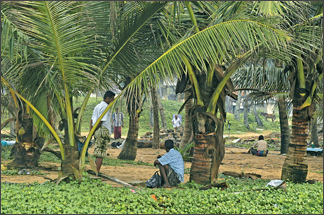
‘Beauty and ugliness’ by Sisira
|
What started off as a workshop soon developed into an exhibition
project. Under the guidance of photographer Jagath Dheerasekara, 10
photographers from diverse areas of the island got together to present
'Days and Beyond', an exhibition of photography comprising themes
selected by the individuals themselves. The exhibition is taking shape
at Alliance Francaise Colombo till May 31.
The focus is mainly on documentary photography and enabled the
participants to express themselves through different subjects that
relate the topic to their individual experiences. The result is a
collection of photographs richly diverse in subject matter as well as
styles.
The participants of 'Days and Beyond' are Chandima Dharmadasa
(Kandy), Dinali Cooray (Colombo), Harshana Henarath (Kurunegala),
Muditha Adikari (Pannipitiya), Neville M. Gamage (Galle), Niroshana de
Silva (Embilipitiya), Sisira Gintotage (Matara), Thushantha Vidanage
(Panadura) and Vajira Hapuhinna (Hanguranketha).
Chandima Dharmadasa deals with the topic "life beyond home". She has
provided an insight into the life of a border in Colombo.
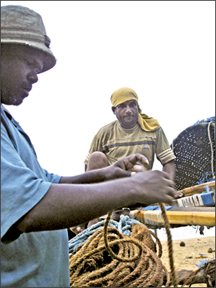 Dinali Cooray presents "lives of pets" where she had traced the
relationship of humans and domestic animals. Dinali Cooray presents "lives of pets" where she had traced the
relationship of humans and domestic animals.
Harshana Henarath has worked on the subject of "getting ready", a
preparatory process in life.
He has captured this feature of life which is manifested in every
physical facet such as semi-constructed houses. Muditha Adikari provides
an interesting study of diverse spider webs and its complex architecture
in "spider web".
He comments that the manner in which the spider struggles in
frequently rebuilding its web in different designs each time is a
beautiful and awe inspiring process to witness. Neville M. Gamage had
turned to a religious theme in his photo-documentary. His subject is
woven around the Buddhist Sunday school, the Daham Pasala. The calmness,
dignity and tranquillity is captured on lense to bring forth his
collection of images.
Niroshana de Silva has captured his son on images to bring "my son"
as his theme. The snaps show his son engaged in a series of activities.
Ratnanantha Aroodguhan who hails from Jaffna sees life in the city to
be confined by walls. His "over the wall" capture the road that leads to
his apartment.
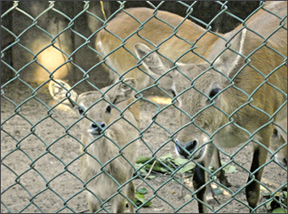 "Beauty and ugliness" is the theme taken up by Sisira Gintotage. His
snaps are moments captured on a beach in all its glory as well as its
sorrowful plight. "Beauty and ugliness" is the theme taken up by Sisira Gintotage. His
snaps are moments captured on a beach in all its glory as well as its
sorrowful plight.
Thushantha Vidanage's "fisherman's life" traces the unseen facets of
the tough life of fishermen in Sri Lanka while Vajira Hapuhinna captured
an insight into the life of animals in the zoo in "cell animals".
"Putting together 'Days and Beyond' has been amazing experience. We
gradually learnt to see photography in a different light. We learnt to
read between the lines rather than take things at face value by
exploring and investigating.
"It was a very satisfying and productive experience," the team
commented on their debut attempt at documentary photography.
RJ
#######################################
Yugandaraya examines backdrop of JVP uprising
Yugandaraya a teledrama directed by Somachandre Wijesuriya examines
the socio-political reasons for the 1971 armed uprising of the youth of
the country against the state. The story is about the decay and fall of
a fictional teacher and his family that lived in the Kegalle area during
1956-71.
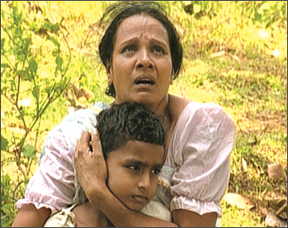 The episode of the original youth uprising three decades ago is now
only in memories of a few people because no film or TV feature maker
tried to tackle that theme. Tissa Abeysekera who viewed the teledrama
has commented that it is a rare theme that has come to the small screen. The episode of the original youth uprising three decades ago is now
only in memories of a few people because no film or TV feature maker
tried to tackle that theme. Tissa Abeysekera who viewed the teledrama
has commented that it is a rare theme that has come to the small screen.
It is based on the English novel 'First Rising' of the director and
examines how political and social forces that unleashed the 1956 victory
of S. W. R. D. Bandaranaike led to the crises of the regime fifteen
years later. The novel was based on years of research and was nominated
for the 1988 Gratiaen Awards. Professor Thiru Kandiah who adjudicated in
the awards commented that the novel portrays the betrayals in the
postcolonial era that led to an impasse in history.
Yugandaraya was shot in scenic Rattota area in 58 days with a cast of
over 60 headed by Maurine Charuni, Somasiri Gamage, Nimal Yativella and
Wimal Jayakody and three British talent headed by Daniel Collins who was
attached to the British Council Colombo. Music is by Ravindra Guruge and
the camera was handled by Asoka Hewage. It was a co-production by the
director and Kosala Tantula, a USA domiciled Sri Lankan. R. S. studio
handled the equipment support.
Brett Lauter, a Californian based TV program agent has reviewed the
drama and has commented that it is 'artistically and technically well
done' and thus the drama is poised on the foreign market.
Dr. Tudor Weerasinghe who was in the panel for reviewing teledramas
for the state teledrama competition has said that Yugandaraya is miles
ahead of over 30 teledramas he has reviewed. Yugandaraya is currently
awaiting release in state or a private channel.
#####################################
Highlights from Raigam Tele Awards 2007
 Raigam Tele Awards 2007 saw a host of top Sri Lankan artistes take to
the stage at BMICH as the ceremony was held for its fourth successive
year. Upcoming young director Senesh Dissanayake Bandara clinched the
award for best director for his creation, Rala Bindena Thena which was
telecast on Swarnavahini. It was also adjudged as the best teledrama of
2007 and was produced by Ananda Abeynayake. Raigam Tele Awards 2007 saw a host of top Sri Lankan artistes take to
the stage at BMICH as the ceremony was held for its fourth successive
year. Upcoming young director Senesh Dissanayake Bandara clinched the
award for best director for his creation, Rala Bindena Thena which was
telecast on Swarnavahini. It was also adjudged as the best teledrama of
2007 and was produced by Ananda Abeynayake.
Lead actress Chandani Seneviratne was named as the best actress for
the third time at the Raigam Tele Award Festival. She bagged this year's
award for her dynamic performance in Rala Bindena Thena while Vishvajith
Gunasekara bagged the award for best actor.
The ever charming Chathurika Peiris won the title of most popular
actress while the talented young Amila Abeysekara strolled away with the
award for most popular actor. Paba, telecast on ITN, was adjudged as the
most popular drama.
The judging panel comprised Kelaniya University's Senior Lecturer
Patrick Ratnayake, Colombo University's senior lecturer Ajantha
Hapuarachchi, Veteran author Jayantha Rukmani Siriwardana, Kelaniya
University's senior lecturer Chandrasiri Bogamuwa, Veteran journalist
Gunasiri Silva and Visharada Edward Jayakody.
The ceremony was put together by Dr. Ravi Liyanage, Kishan Rohana
Theodore, Ganaka Amarasinghe, Jagath Dharmajeewa, Prashantha Nanayakkara
and others.
Speaker W.J.M. Lokubandara was the Chief Guest while Ministers
Bandula Gunawardana, Mahinda Yapa Abeywardana, Lakshman Yapa
Abeywardana, North central Province Governor Karunaratne Divulgane, Dr.
D. B. Nihalsinghe, Ravindara Randeniya and others graced the occasion.
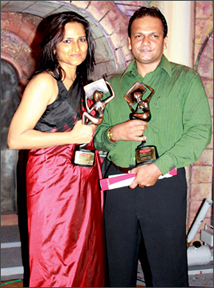
Chandani and Vishvajith |
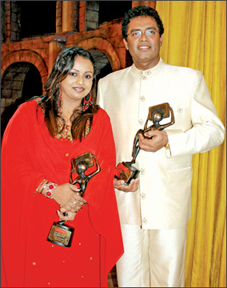
Samitha and Jagath |
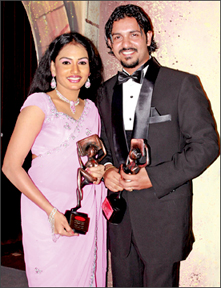
Chathurika and Amila |
RJ
#########################################
Kakul Hathare Ilandariya at Lionel Wendt Theatre
 Kakul Hathare Illandariya is the latest stage play of veteran
Dramatist R. R. Samarakoon who has produced Kelani Palama, Ahasing
Wetunu Minissu, Duwili, Idama, Charitha Dekak, Kaputu Bo and host of
other plays. It will go on the boards at the Lionel Wendt Theatre, on
June 8 at 7 p.m. Kakul Hathare Illandariya is the latest stage play of veteran
Dramatist R. R. Samarakoon who has produced Kelani Palama, Ahasing
Wetunu Minissu, Duwili, Idama, Charitha Dekak, Kaputu Bo and host of
other plays. It will go on the boards at the Lionel Wendt Theatre, on
June 8 at 7 p.m.
Senior lecturer Ariyarathna Kaluarachchi handles the choreography.
The sets are been done by lecturer Lionel Bentharage and the music has
been composed by Shantha Peiris. Ravindra Ariyarathna and Asoka Zoysa
are in charge of the stage management. Sound operator is Chandana
Nishantha Peiries.
Wijaya Nandasiri, Saman Hemarathne, Rathnashila Perera and Anusha
Disanayake play the key roles in the play. Kakul Hathare Ilandariya is
presented by Jude Srimal. |

